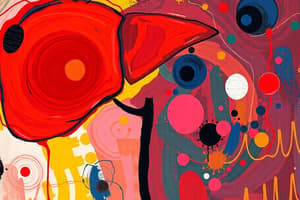Podcast
Questions and Answers
ما هو السبب الرئيسي لحدوث اليرقان عند الأطفال الرضع؟
ما هو السبب الرئيسي لحدوث اليرقان عند الأطفال الرضع؟
- زيادة إنتاج الصفراء بشكل طبيعي (correct)
- عائق في تدفق المرارة
- التهاب الكبد
- انخفاض إنتاج الصفراء
ما هو أحد الأسباب الشائعة لحدوث حصى المرارة؟
ما هو أحد الأسباب الشائعة لحدوث حصى المرارة؟
- الإصابة باليرقان الفسيولوجي
- الإصابة بالتهاب الكبد
- سرطان المرارة
- عائق في تدفق المرارة (correct)
ما هي أحد الأعراض الشائعة لليرقان؟
ما هي أحد الأعراض الشائعة لليرقان؟
- فقدان الشهية
- البراز ذو اللون الغامق (correct)
- الإصابة بالكبد
- الإصابة بحمى
من أحد الأمراض التي يمكن أن تزيد من إنتاج الصفراء في جسم الإنسان؟
من أحد الأمراض التي يمكن أن تزيد من إنتاج الصفراء في جسم الإنسان؟
كيف يتم تشخيص حالات اليرقان عادةً؟
كيف يتم تشخيص حالات اليرقان عادةً؟
ما الذي يشير إليه ارتفاع البيليروبين المباشر في نتائج اختبار الدم؟
ما الذي يشير إليه ارتفاع البيليروبين المباشر في نتائج اختبار الدم؟
ما هي أحد الأساليب الموصى بها للوقاية من التهاب الكبد؟
ما هي أحد الأساليب الموصى بها للوقاية من التهاب الكبد؟
التحقق من لون مزيلات البول والبراز يساعد في تشخيص ما؟
التحقق من لون مزيلات البول والبراز يساعد في تشخيص ما؟
ما هو العلاج الموصى به للتغلب على التهاب الكبد؟
ما هو العلاج الموصى به للتغلب على التهاب الكبد؟
ما هو التشخيص المقترح للاشتباه بحالة هيموليز أو الأمراض قبل الكبد؟
ما هو التشخيص المقترح للاشتباه بحالة هيموليز أو الأمراض قبل الكبد؟
Flashcards are hidden until you start studying
Study Notes
Jaundice
Jaundice is a common condition characterized by the yellowing of the skin and whites of the eyes due to elevated levels of bilirubin—a waste product produced when red blood cells break down. Although it can sometimes indicate serious health issues, jaundice is often treatable and temporary. Here's what you need to know about its main aspects: causal factors, associated signs, diagnostic methods, preventive measures, and treatments.
Causes
Jaundice occurs when there's too much bilirubin in the body. This could happen if:
- Liver function is impaired. When liver cells don't work correctly, bile flow slows, causing excess bilirubin in the bloodstream. Common culprits here are hepatitis, cirrhosis, and drug-induced liver injury.
- Bilirubin production exceeds normal rates. Conditions like hemolytic disease or excessive destruction of red blood cells may cause increased production of bilirubin. In newborns, this type of jaundice is called physiological jaundice of the neonate, which usually resolves without intervention within two weeks after birth.
- Bile flow is obstructed. Gallstones, tumors, parasites, and other blockages in the biliary system can lead to obstructive jaundice.
Symptoms
Most cases of jaundice present with visible yellow discoloration of the skin and sclerae—the whites of your eyes. Other accompanying symptoms might include dark urine, light-colored stool, fatigue, nausea, loss of appetite, abdominal pain, pruritus (itchiness), fever, and chills. Newborns typically display milder symptoms such as poor feeding, lethargy, and slight jaundice starting around day three postpartum.
Diagnosis
Determining the underlying cause of jaundice requires clinical examination followed by various laboratory tests and imaging studies:
- Blood tests measure serum bilirubin concentration and help identify whether levels are elevated.
- Direct bilirubin indicates liver dysfunction or obstruction, while indirect bilirubin suggests hemolysis or prehepatic disorders.
- Urinalysis and stool tests examine the color of both specimens.
- Imaging techniques, such as ultrasound, CT scan, MRI, and X-ray, visualize potential obstructions and abnormalities within the hepatobiliary tract.
Prevention
To minimize the possibility of developing jaundice, focus on maintaining good overall health through healthy lifestyle choices, such as:
- Eating balanced meals containing plenty of fruits, vegetables, lean proteins, and whole grains.
- Practicing safe sex to reduce chances of contracting STDs that could potentially affect liver function.
- Exercising regularly to improve circulation and promote better organ function.
- Staying up-to-date on immunizations to protect against diseases affecting liver health.
- Abstaining from alcohol consumption during pregnancy to decrease the risk of fetal alcohol spectrum disorder, which can result in neonatal jaundice.
Treatment
Treatment for jaundice depends largely upon its underlying cause:
- Lifestyle modifications, such as weight reduction for those who are overweight, can aid in improving general health and promoting proper liver function.
- Medications prescribed to address specific conditions impacting liver health, such as antibiotics for bacterial infections or antipsychotics for mental illnesses.
- Endoscopic procedures involving draining bile ducts or removing gallstones in patients experiencing blocked bile flow.
- Surgery to remove damaged tissue or correct structural anomalies that contribute to liver or bile duct dysfunction.
Remember that knowing the facts about jaundice enables you to take appropriate action if necessary, either preventing its development or initiating prompt medical attention when required.
Studying That Suits You
Use AI to generate personalized quizzes and flashcards to suit your learning preferences.




